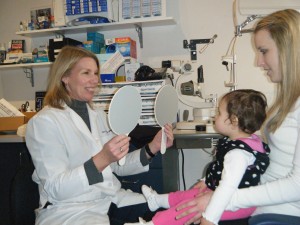An infant’s vision improves significantly during his first 6 months. Basic visual function develops rapidly during the first year.
Newborns focus on objects that are 8-10 inches away and will wince and blink in response to bright light, but only for a brief amount of time. At birth approximate visual acuity is 20/800. Infants will stare intently at high contrast images such as the edges of faces. Newborn eyes may cross or wander for the first 4 months.
By two to three months, babies have an approximate visual acuity of 20/400. At this age, they will track movement as well as smile at objects that are about a foot away. Reaching for objects around 3 months is expected.
At 6 months the vision has improved to at least 20/100. A 6 month old infant will open his mouth to a spoon and will recognize his own face in the mirror. Both eyes should focus equally. Depth perception is developing.
A twelve month old child will have visual acuities of 20/60 and can judge distances fairly well, throw things with precision and pick up small objects with the fingers and thumb.
A comprehensive visual assessment between 9-12 months is recommended, earlier if the infant is at risk for eye or vision disorders. Early intervention is critical to successful vision and treatment.
